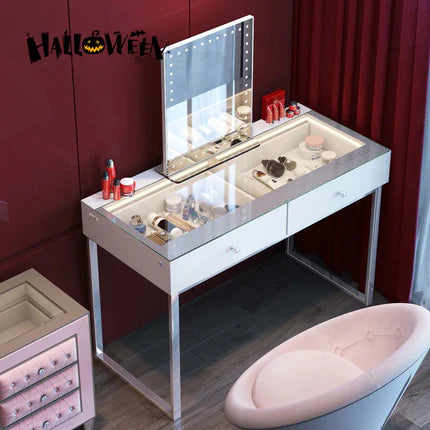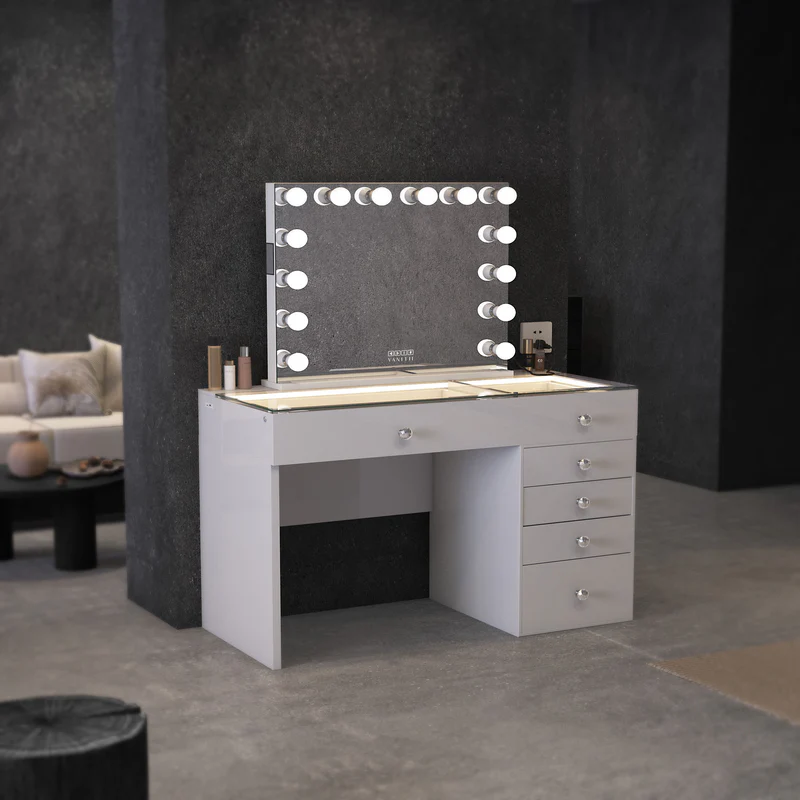While white MDF vanity desks can add brightness to a space, they are also more likely to show stains. The desk's attractiveness might be swiftly ruined by these marks. If you've observed stains on your desk, don't worry; with the correct techniques, they can usually be cleaned. This tutorial will teach you how to maintain the best possible appearance and cleanliness for your white MDF vanity desk. We'll help you maintain the attractiveness of your workstation for years to come by covering everything from stain identification to safe stain removal.

MDF: Everthing You Need to Know
One useful type of engineered wood product is called medium-density fiberboard, or MDF. It is made by artisans using extreme heat and pressure to break down leftover wood residue into fibers, which they then combine with adhesives. The end product is a smooth, solid material devoid of the knots and grain patterns present in real wood. Because of its consistency, MDF is a great material for furniture, especially for vanity desks that need to have a perfect surface.
Why Choose White MDF Vanity Desks?
White MDF vanity desks are becoming more and more popular for a number of good reasons. Their muted color goes well with many different types of interior decor, from traditional to minimalist. Additionally, these bright surfaces reflect light well, giving your area a feeling of greater openness and airiness. A tidy, well-maintained white desk also exudes organization and cleanliness due to its immaculate appearance. But because of their light coloring, flaws and marks stand out more, requiring careful upkeep and inspection.
Types of Finishes
MDF vanity desks can have different surface finishes:
- Paint: A coat of white paint, which can be shiny or dull
- Laminate: A thin plastic layer stuck to the MDF
- Melamine: A special paper layer pressed onto the MDF with heat
Each finish is cleaned differently. For example, paint can scratch more easily, but laminate handles water better.
Common Stains
Knowing what caused the stain helps you clean it. Here are some typical stains:
- Water stains: Leave light or dark marks
- Oil stains: Can soak in quickly
- Ink stains: Hard to remove because of strong color
- Makeup stains: Often mix oil and color
- Food and drink stains: Come in many types
By figuring out what kind of stain you're dealing with, you can pick the best way to clean it without hurting your white MDF vanity desk.

Preparing Your Desk for Cleaning
Necessary Cleaning Supplies
Before you start, gather all of your cleaning supplies. A soft brush and some soft cloths—ideally microfiber ones—are required. Select cleaning supplies that won't harm the surface of your desk. Typical choices are dish soap, white vinegar, and specialty wood cleaners. Remember to wear safety glasses to protect your eyes and rubber gloves to protect your hands. Having everything ready from the beginning can improve the efficiency of your cleaning procedure.
Protecting the Surrounding Area
Before you begin cleaning, take precautions to protect the area surrounding your workstation. To catch spills and drips, use old towels or a plastic sheet underneath the desk. If there are any drawers on your desk, pull them out and cover the contents. Everything on the desk should be taken off and securely stored away from the cleaning area. This setup provides you with a clear workstation and safeguards your possessions.
Initial Dusting
Dust your desk completely before anything else. To remove dust from all surfaces, including edges and decorative elements, use a soft, dry cloth or brush. You can use a little moist towel to remove obstinate dust. Because it gets rid of loose dirt that could damage your desk when you do more thorough cleaning, dusting is an essential initial step. Your desk will be prepared for stain removal and deeper cleaning following a thorough dusting.
How to Clean Fresh Stains on Your Vanity Desk
1. Act Fast When Something Spills
If you spill something on your desk, clean it up right away. Use a clean, dry cloth to soak up any liquid. Don't rub the spill, as this can make the stain bigger and worse. If you spilled something solid, like food, gently scrape it off with a plastic card. The faster you clean up a spill, the less likely it is to leave a permanent mark.
2. Focus on the Stained Area
After you've cleaned up most of the spill, look at the stained spot. Put some painter's tape around the stain to make a border. This helps keep your cleaning products in one place and protects the rest of the desk. It also lets you focus on cleaning just the stained part without damaging other areas.
3. Try Simple Cleaning Methods First
You can often clean new stains with things you have at home. Mix a little dish soap with warm water. Use a soft cloth to gently apply this mixture to the stain. For oily stains, try making a paste with baking soda and water. Put the paste on the stain, wait a few minutes, then wipe it off with a damp cloth. Before using any of these methods on the stain, test them on a hidden part of the desk to make sure they won't cause damage.
How to Remove Stubborn Stains from Your Desk
Sometimes, fresh stains turn into stubborn marks that won't come off easily. Don't worry - with patience and the right approach, you can often remove these tough stains. Follow these steps to tackle even the most persistent stains on your white MDF vanity desk.
Step 1: Check the Stain
Look closely at the stain on your desk. Is it a light surface mark or a deep, set-in stain? Different stains need different cleaning methods. For example, a coffee stain might need a different cleaner than an ink stain. Once you know what kind of stain you're dealing with, you can choose the right cleaning product.
Step 2: Apply the Cleaning Solution
After you pick the right cleaner, it's time to use it. If you're using a store-bought cleaner, follow the instructions on the bottle. If you're making your own, mix it carefully. Apply the cleaner to the stain gently with a soft cloth. Some stains need time for the cleaner to work. A general rule is to let it sit for about 5 minutes, but tough stains might need up to 15 minutes.
Step 3: Clean the Stain Carefully
Now it's time to work on the stain. Use a soft cloth or a very soft brush to gently scrub the area. Don't scrub too hard - you don't want to damage your desk. For tougher stains, you might need to repeat this process a few times. After scrubbing, use a clean, dry cloth to blot the area and soak up the dirty cleaning solution.
Step 4: Rinse the Area
Once the stain is gone, you need to remove any leftover cleaning product. Dampen a clean cloth with plain water and gently wipe the area. This helps remove any soap or cleaner left behind. If you used a strong cleaning product, you might need to use a neutralizer. For example, if you used an acidic cleaner, you might wipe the area with a mixture of water and baking soda to neutralize it. Always finish by drying the area completely with a clean cloth.
Special Cleaning Methods for Different Stains
Not all stains are created equal. Some types of stains, like ink or red wine, can be particularly challenging to remove.
1. Ink and Marker Stains
Ink stains can be tricky, but don't lose hope. Start by dabbing the stain with a cloth soaked in rubbing alcohol. Be careful not to rub, as this can spread the ink. For permanent marker, try using a small amount of non-gel toothpaste. Gently rub it on the stain, let it sit for a few minutes, then wipe it off with a damp cloth. Always test these methods on a hidden area first to ensure they won't damage the non-gel toothpaste
Stains
Makeup often contains oils that can leave stubborn marks. For these stains, try using a small amount of dish soap mixed with warm water. Apply this mixture gently with a soft cloth, then rinse with clean water. For tougher makeup stains, you might need to use a specialized cleaner designed for removing cosmetics. Be sure to choose one that's safe for your desk's surface.
3. Water Stains and Rings
Water stains often leave white rings on furniture. To remove these, try using a mixture of equal parts white vinegar and olive oil. Apply this mixture to the stain with a soft cloth, rubbing gently in the direction of the wood grain. Let it sit for an hour, then wipe it off with a clean, dry cloth. This method can often lift out water stains without damaging your desk's surface.
How to Keep Your White MDF Vanity Desk Clean and Stain-Free
Keeping your desk clean is easier than removing stains later. Here are some simple ways to protect your white MDF vanity desk and keep it looking new.
Daily Habits for a Clean Desk
Clean your desk every day with a soft, dry cloth. This stops dust from building up. If you use makeup at your desk, put a small tray or mat under your products to catch spills. Keep some gentle cleaning wipes nearby for quick cleanups. If you spill anything, clean it up right away to stop stains from setting in.
Weekly Cleaning
Once a week, give your desk a better cleaning. Use a mild soap and water mix or a cleaner made for MDF surfaces. Don't use strong chemicals that could hurt your desk. Dust all parts of the desk, even the hard-to-reach spots. Then wipe everything down with your cleaner. Don't forget to clean and tidy the drawers too.
Things to Buy to Protect Your Desk
You can buy some items to help protect your desk. A clear desk mat can stop scratches and spills but still let you see the white desk underneath. Always use coasters under drinks to prevent water rings. In areas where you use makeup or other things that might stain, use small mats that you can wash or replace easily if they get dirty.
Keep Your Desk Looking Great
Your white MDF vanity desk can stay beautiful with the right care. Clean spills quickly, use the correct methods for different stains, and make daily cleaning a habit. Regular care will keep your desk looking new and prevent damage. With these tips, you can easily maintain your desk's clean appearance. Start using these methods today to protect your desk and keep it as a stunning part of your room for years to come.




Leave a comment
This site is protected by hCaptcha and the hCaptcha Privacy Policy and Terms of Service apply.